Gas and Nuclear Power Stations
Sakshi Education

1. Introduction of Nuclear Power Stations:
The unending hunger for electricity with increase in the population and industrial growth created a need for nuclear power plant. Moreover, the reserves of fossil fuels coal, oil and gas are fast depleting. Thus there is tendency seeking alternate source of energy and the nuclear power is the alternate source which can meet future energy demands in the world. One of its main attractions is the huge amount of energy that can be released from a small quantity of active material. The energy obtained by burning of 1kg of uranium would give energy equivalent 3,000 tones of higher grade coal.
The nuclear power station would be cheaper by 8 to 10 paisa per kwh than from thermal plants, at a distances 800km from pit heads.
The area’s most suitable for nuclear power station are western UP, Northern and western Rajasthan, Punjab and Haryana.
The energy conversion involved in nuclear power station as shown above.
The selection of site for nuclear power station is
The nuclear power plant consist of a nuclear reactor, heat exchanger or super heater for converting water into steam by using the heat generated in nuclear reactor, steam turbine, alternator, condenser etc. As conventional steam power plant water for raising steam forms a closed feed system. However the reactor and the cooling circuit have to be heavily shielded to eliminate radiation hazards.
The amount of heat energy generated in breaking of atoms of uranium or other similar metals of large atomic weight into metals of lower atomic weight by fission process in an atomic reactor is extracted by pumping fluid or molten metal like liquid sodium or gas through the pile.
The heated metal or gas is then allowed to exchange its heat to the heat exchanger by circulation. In heat exchanger the gas is heated or steam is generated, which are utilized to drive gas turbine or steam turbine to an alternator generating electrical energy.
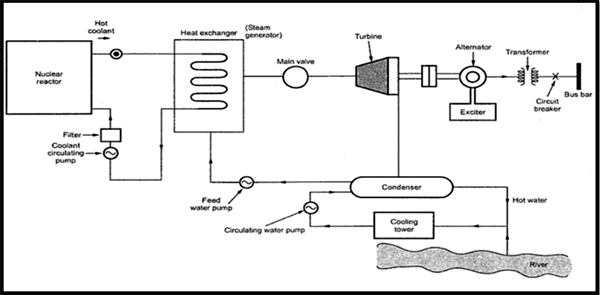
The layout of a nuclear power plant due to consideration should be given to safety, operating convenience and economy. One of the important operational areas in a reactor building is the charge hall which is used to refueling operation. This is located directly over the reactor core.
The main parts of a nuclear power plants are nuclear reactor, heat exchanger, turbine, alternator, transformers, bus bars, condenser, cooling towers and generators as show in above schematic arrangement of nuclear power plant.
a. Nuclear Fission: This is the process in which heavy nucleus is spilt when bombarded by certain particles such a reaction is possible only with heavy nuclei such as 233U, 235U and 239Pu.
92
92
94
Although the fission can be caused by bombarding with high energy particles such as protons, neutrons and X-rays as well as it neutrons, are most suited for fission.
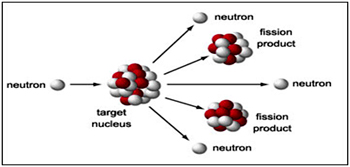
The splitting of a heavy nucleus into two or more smaller nuclei is termed nuclear fission. The process of fission is always accompanied by the ejection of two or more neutrons in liberation of vast energy.

In fission reaction the mass of the product is less than that of the reactant. A loss of about 0.2amu per uranium atom occurs. This mass is converted into a energy 0.2x931.5i.e.187MeV.generally 1fission of 235- U causes a release of 200 MeV of energy.
200 MeV=200x1.6x10x0.13=3.2x10x0.11joules.
If all atmos of 1 kg of pure U-235 were fissioned,the energy released would be equivalent to tat contained in 3x10x0.6kg of coal wih a calorific value of 6,000K.cal/kg.natural uranium contain 0.7%if fission efficency is 50% fission of 1kg of natural uranium would given energy 10,500 kg of coal.
b) Chain reaction:
U-235 nucleus when hit by a neutron undergoes the reaction.

Each of the three neutrons produced in the reaction strikes another U-235 nucleus, thus causing nine subsequent reactions. These nine reactions in turn further rise to give twenty-seven reactions by multiplication of three each, as shown figure is referred to as a chain reaction.
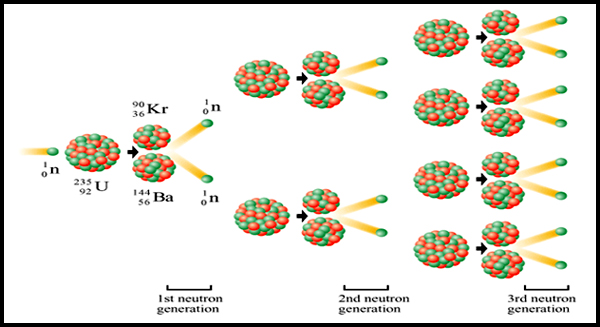
Figure: chain reaction
A chain reaction may be release two or three a neutrons at each fission process. It may be defined as a fission reaction where the neutron from a previous step repeated to propagate and repeated the reaction.
The minimum mass of fissionable material required to sustain chain reaction is called critical mass. The critical mass varies for each reaction for U-235 fission reaction it is about 10kg.
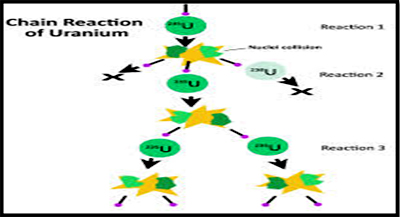
Even a single fission reaction produces a large amount of energy. The chain reactions that consist of innumerable fission reaction will therefore generate energy many times down the chain reaction.
The Materials that are fissionable by thermal or low speed neutrons are U-233, U-235, and Pu-239.
c) Nuclear fuels:
The fuels mainly used are natural uranium (U-235), enriched uranium and plutonium, where U-235 natural uranium is a parent material. The materials U-235, U-233 and Pu-239 are called fissionable materials. The only fissionable nuclear fuel occurs in nature is uranium, of which 99.3% is U-238 and 0.7%, is U-235 and U-234 is only a trace. Out of these isotopes only U-235 will fission in chain reaction. Fissionable materials Pu-239 and U-233 are formed in nuclear reactors during fission process from U-238 and Th-234 respectively due to absorption of neutron without fission. This process is given below.
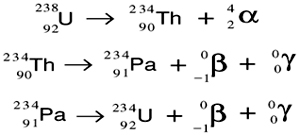
The above process is called conversion. Absorption of neutron by U-238 produces U-239,which is unstable with half life period 23minutes and decay into neptunium with emission of an electrons 230 Np which half life period is 2.3 days is likewise transformed into Pu-239.
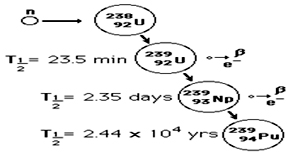
The above process is called breeding.
3. Principle of operation of Nuclear reactor:
Reactor, part of nuclear power plant is where nuclear fuels is subjected to nuclear fission and the energy released in the process is utilized to heat the coolant which may is turn generate steam or be used in gas turbine.
The main function of the reactor is to be control the emission and absorption of neutrons.
The neutrons emitted as a result of chain reaction are accounted for in the following ways.
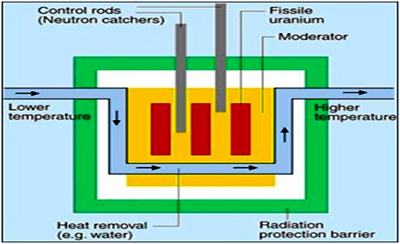
Figure: Nuclear reactor
A nuclear reactor consists of the following basic components as shown in figure as Reactor core, Moderator, Control rods, coolant ,Reflector, Thermal shielding reactor vessel, biological shielding.
Reactor core:
It contains a number of fuel rods made of fissile material. They may be diluted with non-fissionable material for better control of the reaction or to reduce the damage from fission product poisoning. The size of core, just sufficient to maintain a chain reaction is the critical size. It can be using enriched uranium.
Moderator:
Neutrons produced by fission process are ejected from the nuclear at very high velocity of about 1.5x10x0.7m/s and therefore have a very large kinetic energy and as termed as fast neutrons. The elements which can undergo a fission reaction with fast neutrons are U-233, U235 andPu-239.
Natural uranium contains only 0.7% U-235 fast neutrons are allowed down by elastic scatting process in chain reaction can still occur. But during this process there is possibility getting absorbed by U-238 and the chain reaction may not be maintained. If the proportion of U-235 in the metal is increase to more than 10% the above absorption effect can be overcome and a chain reaction is possible. This occurs in fast reactors but the enriching process is expensive.
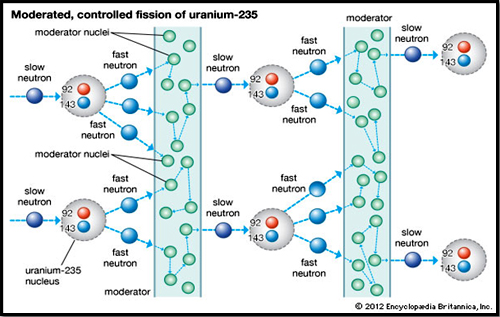
Figure: Moderator
Control rods: The control rods are inserted into the reactor core from the top of the reactor vessel. These rods regulate the fission process in the reactor absorbing the excess neutrons these can be moved in to out of the holes in the reactor core assembly.
Controls rods are meant for controlling the rate of fission of U-235.these are made of boron-10, cadmium or hafnium that absorbs some of the slowed neutrons.
In a reactor, nuclear chain reaction has to be initiated when started from cold, and the chain reaction is to be maintained at a steady value durying the operation of reactor. Also the reactor must be able to shut-down automatically under emergency conditions. All this requires a control of reactor so as to prevent the melting of fuel roads, disintegration of coolant and destruction of reactor as the amount of energy released enormous.

Figure: control rods
Reflectors:
This completely surrounds the reactor core within the thermal shielding arrangement and bounces back most of the neutrons that escape from the fuel core. This conserves the nuclear fuel, as the low speed neutrons thus returned are useful in counting the chain reaction. The reflector gets heated due to collision of neutrons with its atom; therefore, its cooling is essential. The reflector should have good neutron scattering properties and preferably a small tendency to absorb neutrons.
Coolants:
It is a medium through which the heat generated in the reactor is transferred to the heat exchanger for further utilization in power generation. At times, when water is used as coolant it takes up heat and gets converted into steam in the reactor, which is directly used for driving steam turbines. Coolant flows through and around the reactor core. It performs the additional function keeping the interior of reactor at desired temperature.
A good coolant should not absorb neutrons, should be non-oxidising, non-toxic and non-corrosive and have high chemical and radiation stability and good heat transfer capability. Air, helium, hydrogen and co2 amongst the gases, light and heavy water amongst the liquids, and the molten sodium and lithium amongst the metals are the materials used as coolant.

Figure: coolant
4. Types of Nuclear reactors:
The types of nuclear reactors are as following
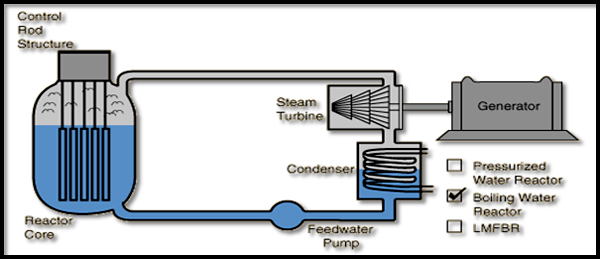
Figure: Nuclear reactor
Boiling water reactor (BWR):
This is the simplest type of water reactor. It has a steel pressure vessel surrounded by a concrete shield. Fuel used is enriched uranium oxide. Ordinary water is used both as a moderator and coolant.

Figure: Boiling water reactor (BWR)
The steam is generated in the reactor itself. The feed water enters the reactor vessel at the bottom and takes the heat produced due to fission of fuel and gets converted into steam. This stem leaves the reactors at the top and after passing through turbine and condenser returns to the reactor. Uranium fuel elements are arranged in a particular lattice from inside the pressure vessel as contains water.
Advantages:
It is a thermal reactor, uses enriched uranium oxide clad in zinc alloy as fuel. The pressure vessel is of steel, water under pressure is both as coolant and moderator. The pressure vessel and the heat is surrounded by the concrete shield in the reactor, bulk boiling water is prevented as the water is pressurized to about 150 atmospheres.
The hot water from the reactor flows to a heat exchanger where the heat transferred to the feed water to generate steam. The secondary cooling operators at a low pressure, the primary coolant flows from the heat exchanger to the primary circulating pump and it pumps back to the reactor. The steam is condenser, where it condensates and returns to heat exchanger forming a closed circuit.

Figure: Pressurized water reactor (PWR)
Advantages:
A fast breeder reactor is a small vessel in which the required quantity of enriched uranium or plutonium is kept without a moderator and the fissionable fuel core is surrounded by a blanket of fertile material,that absorbs neutrons produced by the fisioning of U-235 and procedures fissile material Pu-239 respectively. Two heat exchanger are used the reactor core is cooled by liquid metal.
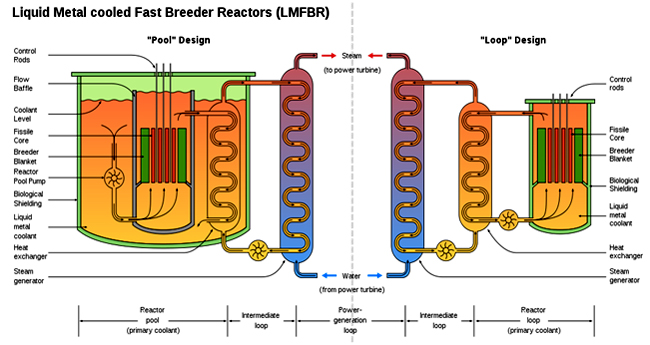
Figure: Fast breeder reactor
In the second heat exchanger the coolant is again liquid sodium which transfers heat to the feed water to generate steam.
This prevents the possibility of a sodium water reaction with the radioactive sodium the arrangements of liquid metal fast breeder reactors (LMFBR) is given above figure
In the fast breeder reactors neutron shielding is provided by using boron, light water, oil or graphite. The core of fast breeder reactor needs high enrichment to reduce fuel cost effect, it is imperatives high ratings the core consist of 30%fuel, 50%coolant and 20%strctural material.
7. Gas Power Stations
The Gas power station is a power plant in which a gas turbine is used as a prime mover for the generation of electrical energy. In a gas turbine, the working medium is either mixture of combustion products and air or heated air at a certain pressure and a higher initial temperature with respect design a gas power station is balding working gas expands and heat energy is converted into kinetic energy and then to work shaft rotation.
Principle of Operation and Components:
The principal of a gas turbine power plant is that the turbo-compressor compresses working medium at high pressure and then it is burnt in the combustion chamber were the combustion takes place at a constant pressure and temperature. The working medium is raised, where the high pressure and temperature working medium is then expanded in a gas turbine coupled to generator. The overall efficiency gas turbines depends on prime mover which is limit due to the fact that a large portion of the power developed by the driving the compressor and also temperature safely.
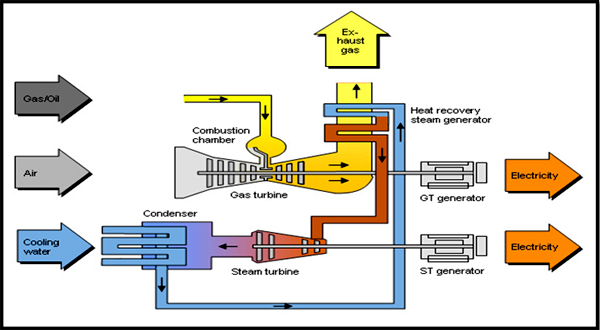
The components of gas turbine power plants consists of the reaction type non condensing turbine, a compressor mounted on same shat and coupled through turbine, the combustion chamber and alternator coupled to the turbine itself such as starting motor auxiliary lubrication pump, oil system, fuel system and duct system etc. The combustion chamber consists of vessel into which the air at high pressure from the compressor is fed. The fuel is injected in to combustion chamber and burnt resulting in a steam of air supplied to the compressor and a part of air is delivered a head of the burning fuel in order to cool very hot combustion products and to bring in a temperature around 800c. When these are allowed in to turbine without causing damages to the rows blade part, the power developed by the gases passes through the turbine and is used to run the compressor, auxiliary and rest is used to generate electrical energy driving to generator.
Advantages:
The unending hunger for electricity with increase in the population and industrial growth created a need for nuclear power plant. Moreover, the reserves of fossil fuels coal, oil and gas are fast depleting. Thus there is tendency seeking alternate source of energy and the nuclear power is the alternate source which can meet future energy demands in the world. One of its main attractions is the huge amount of energy that can be released from a small quantity of active material. The energy obtained by burning of 1kg of uranium would give energy equivalent 3,000 tones of higher grade coal.
The nuclear power station would be cheaper by 8 to 10 paisa per kwh than from thermal plants, at a distances 800km from pit heads.
The area’s most suitable for nuclear power station are western UP, Northern and western Rajasthan, Punjab and Haryana.
The energy conversion involved in nuclear power station as shown above.
The selection of site for nuclear power station is
- Availability of water supply, as sufficient water is required for cooling etc; therefore the site selected for plant should be near a river, lake by sea side.
- Distance from populated area the nearest populated area from the point of view of safety as there is a danger of presences of radio -activity atmosphere near the plant.
- Transportation facilities needs very little fuel because it requires fuel transportation.
- Nearness of load center plant should be there near the load center as possible with safety consideration in order to reduce the transmission cost.
- Availability of space for disposal of waste the site should have space because disposal the waste of radio-active.
- Type of land should be substrata must be strong enough to support heavy reactors which may be weight as high as 1, 00,000tonnes.
The nuclear power plant consist of a nuclear reactor, heat exchanger or super heater for converting water into steam by using the heat generated in nuclear reactor, steam turbine, alternator, condenser etc. As conventional steam power plant water for raising steam forms a closed feed system. However the reactor and the cooling circuit have to be heavily shielded to eliminate radiation hazards.
The amount of heat energy generated in breaking of atoms of uranium or other similar metals of large atomic weight into metals of lower atomic weight by fission process in an atomic reactor is extracted by pumping fluid or molten metal like liquid sodium or gas through the pile.
The heated metal or gas is then allowed to exchange its heat to the heat exchanger by circulation. In heat exchanger the gas is heated or steam is generated, which are utilized to drive gas turbine or steam turbine to an alternator generating electrical energy.

The layout of a nuclear power plant due to consideration should be given to safety, operating convenience and economy. One of the important operational areas in a reactor building is the charge hall which is used to refueling operation. This is located directly over the reactor core.
The main parts of a nuclear power plants are nuclear reactor, heat exchanger, turbine, alternator, transformers, bus bars, condenser, cooling towers and generators as show in above schematic arrangement of nuclear power plant.
a. Nuclear Fission: This is the process in which heavy nucleus is spilt when bombarded by certain particles such a reaction is possible only with heavy nuclei such as 233U, 235U and 239Pu.
92
92
94
Although the fission can be caused by bombarding with high energy particles such as protons, neutrons and X-rays as well as it neutrons, are most suited for fission.

The splitting of a heavy nucleus into two or more smaller nuclei is termed nuclear fission. The process of fission is always accompanied by the ejection of two or more neutrons in liberation of vast energy.

In fission reaction the mass of the product is less than that of the reactant. A loss of about 0.2amu per uranium atom occurs. This mass is converted into a energy 0.2x931.5i.e.187MeV.generally 1fission of 235- U causes a release of 200 MeV of energy.
200 MeV=200x1.6x10x0.13=3.2x10x0.11joules.
If all atmos of 1 kg of pure U-235 were fissioned,the energy released would be equivalent to tat contained in 3x10x0.6kg of coal wih a calorific value of 6,000K.cal/kg.natural uranium contain 0.7%if fission efficency is 50% fission of 1kg of natural uranium would given energy 10,500 kg of coal.
b) Chain reaction:
U-235 nucleus when hit by a neutron undergoes the reaction.

Each of the three neutrons produced in the reaction strikes another U-235 nucleus, thus causing nine subsequent reactions. These nine reactions in turn further rise to give twenty-seven reactions by multiplication of three each, as shown figure is referred to as a chain reaction.

Figure: chain reaction
A chain reaction may be release two or three a neutrons at each fission process. It may be defined as a fission reaction where the neutron from a previous step repeated to propagate and repeated the reaction.
The minimum mass of fissionable material required to sustain chain reaction is called critical mass. The critical mass varies for each reaction for U-235 fission reaction it is about 10kg.

Even a single fission reaction produces a large amount of energy. The chain reactions that consist of innumerable fission reaction will therefore generate energy many times down the chain reaction.
The Materials that are fissionable by thermal or low speed neutrons are U-233, U-235, and Pu-239.
c) Nuclear fuels:
The fuels mainly used are natural uranium (U-235), enriched uranium and plutonium, where U-235 natural uranium is a parent material. The materials U-235, U-233 and Pu-239 are called fissionable materials. The only fissionable nuclear fuel occurs in nature is uranium, of which 99.3% is U-238 and 0.7%, is U-235 and U-234 is only a trace. Out of these isotopes only U-235 will fission in chain reaction. Fissionable materials Pu-239 and U-233 are formed in nuclear reactors during fission process from U-238 and Th-234 respectively due to absorption of neutron without fission. This process is given below.

The above process is called conversion. Absorption of neutron by U-238 produces U-239,which is unstable with half life period 23minutes and decay into neptunium with emission of an electrons 230 Np which half life period is 2.3 days is likewise transformed into Pu-239.

The above process is called breeding.
3. Principle of operation of Nuclear reactor:
Reactor, part of nuclear power plant is where nuclear fuels is subjected to nuclear fission and the energy released in the process is utilized to heat the coolant which may is turn generate steam or be used in gas turbine.
The main function of the reactor is to be control the emission and absorption of neutrons.
The neutrons emitted as a result of chain reaction are accounted for in the following ways.
- Non –fission absorption by control rod materials, moderator materials, fission fragments and impurities.
- Non –fission absorption by U-238 present in natural uranium to from fissionable Pu-239.
- Fission absorption by U-235, Pu-239 and U-233.
- Escape from the fissionable material.

Figure: Nuclear reactor
A nuclear reactor consists of the following basic components as shown in figure as Reactor core, Moderator, Control rods, coolant ,Reflector, Thermal shielding reactor vessel, biological shielding.
Reactor core:
It contains a number of fuel rods made of fissile material. They may be diluted with non-fissionable material for better control of the reaction or to reduce the damage from fission product poisoning. The size of core, just sufficient to maintain a chain reaction is the critical size. It can be using enriched uranium.
Moderator:
Neutrons produced by fission process are ejected from the nuclear at very high velocity of about 1.5x10x0.7m/s and therefore have a very large kinetic energy and as termed as fast neutrons. The elements which can undergo a fission reaction with fast neutrons are U-233, U235 andPu-239.
Natural uranium contains only 0.7% U-235 fast neutrons are allowed down by elastic scatting process in chain reaction can still occur. But during this process there is possibility getting absorbed by U-238 and the chain reaction may not be maintained. If the proportion of U-235 in the metal is increase to more than 10% the above absorption effect can be overcome and a chain reaction is possible. This occurs in fast reactors but the enriching process is expensive.

Figure: Moderator
Control rods: The control rods are inserted into the reactor core from the top of the reactor vessel. These rods regulate the fission process in the reactor absorbing the excess neutrons these can be moved in to out of the holes in the reactor core assembly.
Controls rods are meant for controlling the rate of fission of U-235.these are made of boron-10, cadmium or hafnium that absorbs some of the slowed neutrons.
In a reactor, nuclear chain reaction has to be initiated when started from cold, and the chain reaction is to be maintained at a steady value durying the operation of reactor. Also the reactor must be able to shut-down automatically under emergency conditions. All this requires a control of reactor so as to prevent the melting of fuel roads, disintegration of coolant and destruction of reactor as the amount of energy released enormous.

Figure: control rods
Reflectors:
This completely surrounds the reactor core within the thermal shielding arrangement and bounces back most of the neutrons that escape from the fuel core. This conserves the nuclear fuel, as the low speed neutrons thus returned are useful in counting the chain reaction. The reflector gets heated due to collision of neutrons with its atom; therefore, its cooling is essential. The reflector should have good neutron scattering properties and preferably a small tendency to absorb neutrons.
Coolants:
It is a medium through which the heat generated in the reactor is transferred to the heat exchanger for further utilization in power generation. At times, when water is used as coolant it takes up heat and gets converted into steam in the reactor, which is directly used for driving steam turbines. Coolant flows through and around the reactor core. It performs the additional function keeping the interior of reactor at desired temperature.
A good coolant should not absorb neutrons, should be non-oxidising, non-toxic and non-corrosive and have high chemical and radiation stability and good heat transfer capability. Air, helium, hydrogen and co2 amongst the gases, light and heavy water amongst the liquids, and the molten sodium and lithium amongst the metals are the materials used as coolant.

Figure: coolant
4. Types of Nuclear reactors:
The types of nuclear reactors are as following
- Boiling water reactors(BWR)
- Pressurized water reactor(PWR)
- Gas cooled reactor
- Heavy water cooled and moderated(CANDU)
- Liquid metal cooled reactor
- Fast-Breeder reactor.

Figure: Nuclear reactor
Boiling water reactor (BWR):
This is the simplest type of water reactor. It has a steel pressure vessel surrounded by a concrete shield. Fuel used is enriched uranium oxide. Ordinary water is used both as a moderator and coolant.

Figure: Boiling water reactor (BWR)
The steam is generated in the reactor itself. The feed water enters the reactor vessel at the bottom and takes the heat produced due to fission of fuel and gets converted into steam. This stem leaves the reactors at the top and after passing through turbine and condenser returns to the reactor. Uranium fuel elements are arranged in a particular lattice from inside the pressure vessel as contains water.
Advantages:
- High steam pressure.
- Simple construction and eliminating heat exchanger.
- Reduction in cost and gain in thermal efficiency.
- Overall efficiency is 33%.
- Wastage of steam results in lowering of thermal efficiency on part load operation.
- It cannot meet sudden increase in load.
It is a thermal reactor, uses enriched uranium oxide clad in zinc alloy as fuel. The pressure vessel is of steel, water under pressure is both as coolant and moderator. The pressure vessel and the heat is surrounded by the concrete shield in the reactor, bulk boiling water is prevented as the water is pressurized to about 150 atmospheres.
The hot water from the reactor flows to a heat exchanger where the heat transferred to the feed water to generate steam. The secondary cooling operators at a low pressure, the primary coolant flows from the heat exchanger to the primary circulating pump and it pumps back to the reactor. The steam is condenser, where it condensates and returns to heat exchanger forming a closed circuit.

Figure: Pressurized water reactor (PWR)
Advantages:
- Cheap light water can be used as coolant and moderator.
- High power density.
- Isolation of radioactive materials from the main stream system.
- Overall efficiency is about 33%.
- High losses from heat exchanger.
- High power consumption by auxiliaries.
- Use of expensive cladding material for prevention of corrosion.
A fast breeder reactor is a small vessel in which the required quantity of enriched uranium or plutonium is kept without a moderator and the fissionable fuel core is surrounded by a blanket of fertile material,that absorbs neutrons produced by the fisioning of U-235 and procedures fissile material Pu-239 respectively. Two heat exchanger are used the reactor core is cooled by liquid metal.

Figure: Fast breeder reactor
In the second heat exchanger the coolant is again liquid sodium which transfers heat to the feed water to generate steam.
This prevents the possibility of a sodium water reaction with the radioactive sodium the arrangements of liquid metal fast breeder reactors (LMFBR) is given above figure
In the fast breeder reactors neutron shielding is provided by using boron, light water, oil or graphite. The core of fast breeder reactor needs high enrichment to reduce fuel cost effect, it is imperatives high ratings the core consist of 30%fuel, 50%coolant and 20%strctural material.
7. Gas Power Stations
The Gas power station is a power plant in which a gas turbine is used as a prime mover for the generation of electrical energy. In a gas turbine, the working medium is either mixture of combustion products and air or heated air at a certain pressure and a higher initial temperature with respect design a gas power station is balding working gas expands and heat energy is converted into kinetic energy and then to work shaft rotation.
Principle of Operation and Components:
The principal of a gas turbine power plant is that the turbo-compressor compresses working medium at high pressure and then it is burnt in the combustion chamber were the combustion takes place at a constant pressure and temperature. The working medium is raised, where the high pressure and temperature working medium is then expanded in a gas turbine coupled to generator. The overall efficiency gas turbines depends on prime mover which is limit due to the fact that a large portion of the power developed by the driving the compressor and also temperature safely.

The components of gas turbine power plants consists of the reaction type non condensing turbine, a compressor mounted on same shat and coupled through turbine, the combustion chamber and alternator coupled to the turbine itself such as starting motor auxiliary lubrication pump, oil system, fuel system and duct system etc. The combustion chamber consists of vessel into which the air at high pressure from the compressor is fed. The fuel is injected in to combustion chamber and burnt resulting in a steam of air supplied to the compressor and a part of air is delivered a head of the burning fuel in order to cool very hot combustion products and to bring in a temperature around 800c. When these are allowed in to turbine without causing damages to the rows blade part, the power developed by the gases passes through the turbine and is used to run the compressor, auxiliary and rest is used to generate electrical energy driving to generator.
Advantages:
- Simplicity of design and installation.
- Simple lubrication system.
- Low initial cost.
- High reliability.
- Requiring small building spaces and light foundation.
- Requiring little cooling water.
- Clean exhaust requiring no stack.
Published date : 31 Jan 2015 05:26PM






